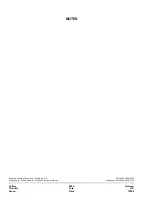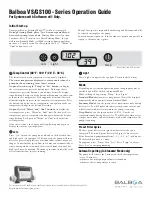
035-18549-000-B-0402
Unitary Products Group
17
OPERATION
GENERAL
During the cooling cycle, when the reversing valve
solenoid becomes energized, operation will be the
same as any conventional air conditioning system.
During the heating cycle, when the reversing valve
solenoid becomes de-energized, compressor dis-
charge gas will be diverted to the indoor coil and the
outdoor coil will become the evaporator.
Refer to Figure 7 for illustration showing the flow of
refrigerant through a heat pump system.
SYSTEM SEQUENCE OF OPERATION
The following sequences of operation are based on
using the manual changeover thermostat. Refer to the
respective unit wiring diagram.
COOLING OPERATION
1.
The following controls will be energized through
terminal O on the thermostat to put the system in
the cooling mode.
• Relay RW (460 volt units) and RVS (230 volt
units) and reversing valve solenoid.
2.
If the fan switch on the thermostat is in the “ON”
position, indoor section blower motor contactor
10M will be energized through terminal G to pro-
vide continuous blower operation. If the switch is in
the “AUTO” position, the blower will operate only
when the thermostat calls for cooling operation.
3.
When TC1 of the thermostat closes on a demand
for cooling, a circuit is made from terminal Y
through the defrost control board and safety
switches to energize contactor 1M (on 460 volt
units) and relay RY1 to start the compressor. Con-
tactor 2M is energized through the NO contacts of
RY1-1 (on 460 volt units) and the NC contacts of
K2 on the defrost control board in order to start the
outdoor fan motors.
4.
Relay RY1 also prevents the 10KW portion of
accessory electric heat referenced as standby
electric heat from being utilized whenever the com-
pressor is in operation. This part of the circuit is
covered under HEATING OPERATION.
5.
The thermostat will cycle the unit to satisfy the
cooling requirements of the conditioned space.
6.
After the unit has shutdown from a cooling cycle or
a power interruption, the anti-short cycle feature of
the defrost control board will not permit the unit to
restart for 5 minutes. This feature prevents the unit
from short cycling.
7.
If the discharge pressure reaches 430 psig, the HP
control will open and the defrost control board will
lock out the compressor. If the discharge tempera-
ture reaches 255°F, 2TH thermostat will open and
the defrost control board will lock out the compres-
sor. If the suction pressure falls to 7 psig, the low
pressure switch will open and the defrost control
will lock out the compressor.
8.
If the control that caused the lockout has automati-
cally reset, the unit can be restarted by one of the
following:
a.
Turning the system switch on the thermostat to the
“OFF” position and back to the “COOLING” position.
b.
Increasing the set point on the thermostat above the
temperature in the conditioned space and then
returning it to its original setting.
Opening and closing the power supply main disconnect
switch.
IN ALL THREE RESET METHODS DESCRIBED
ABOVE, A FIVE MINUTE TIME DELAY WILL TAKE
PLACE AFTER THE RESET BEFORE THE UNIT
WILL RESTART.
Reversing valves and check valves are precise
mechanical devices and will not tolerate any
mechanical abuse such as hammering. If a
refrigerant system isn't properly cleaned after a
compressor burn-out, scale may build up at
these devices and prevent them from operating
properly.








































